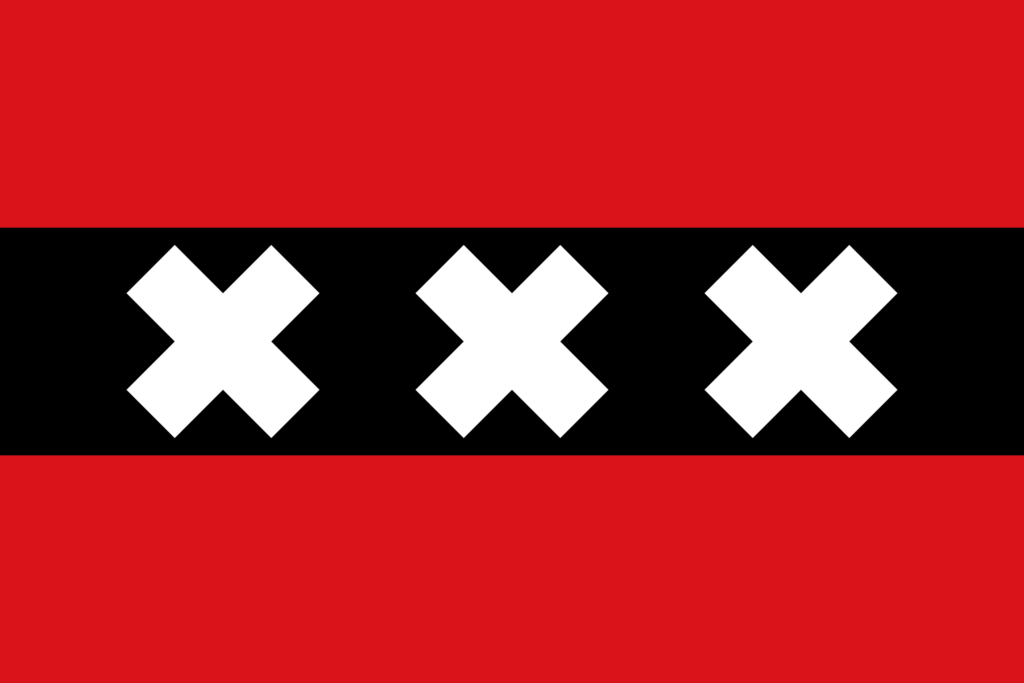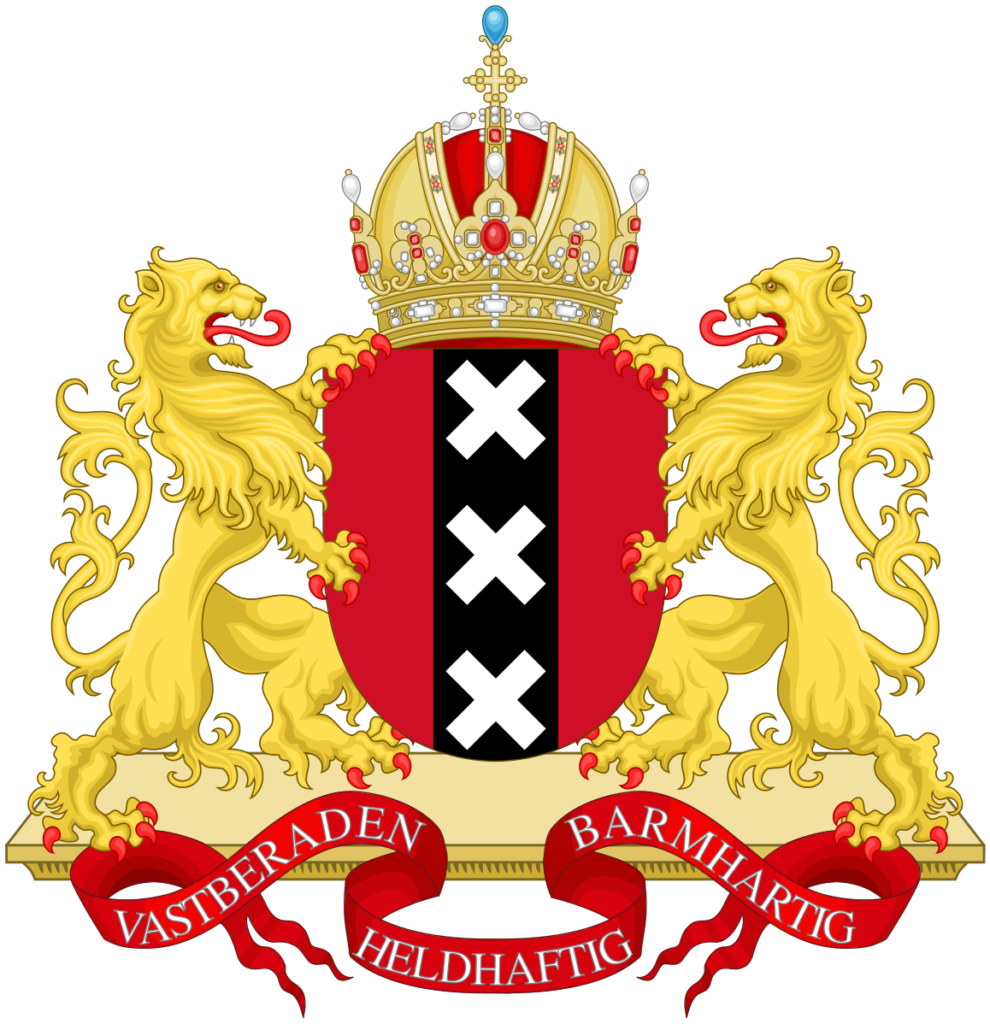“Why are there three Xs on Amsterdam’s flag?” And “What do they mean?” If you live in Amsterdam, like me, you’ve probably had visitors ask these questions multiple times.
You can’t blame them, the place does have a reputation.
Even before tourists get here, they’re already thinking about a certain area of town. You know it, it’s the one with a red glow and people practising the world’s oldest profession. ❌❌❌
Interestingly, the flag isn’t just a depiction of the triple-X entertainment that Amsterdam usually has to offer. Instead, it’s the official symbol of the Dutch capital.
What does the Amsterdam flag look like?
Just in case you’re not familiar with the flag, let’s have a look. It has three horizontal stripes — red, black, and red. The black one is slightly thinner, and it has three white Xs in it.

Why does Amsterdam’s flag have three crosses?
Depending on whether you have the maturity level of a teenager or not, I have some good news (or bad news): those Xs find their origins in Christianity.
That’s right, the XXX on Amsterdam’s flag is actually representative of St. Andrew’s three crosses, one of Jesus’ apostles, who was crucified on an X-shaped cross.
Yes, I was disappointed by that answer too.
READ MORE | A Sexscraper? Here are Amsterdam’s plans for a new Red Light District
St. Andrew also used to be a fisherman, that is, during the first century AD. But, it’s interesting to know that, back in 1505, when Amsterdam was a renowned fishing town, all the registered ships that sailed around Amsterdam had this flag hanging on from their boats. 🛶
Unlike what many people may think, it’s actually just a funny (or unfortunate) coincidence that the Amsterdam flag’s triple X symbol is the same as, well, adult entertainment. The flag’s symbols have nothing to do with sex.
Where do the three Xs on the Amsterdam flag come from?
As cool as the flag looks on its own, it doesn’t usually stand on its own. In reality, it’s borrowed from the city’s coat of arms, where the popular red flag rests as the centrepiece.

A common legend about the flag is that the three crosses represent fire, floods, and the black plague. Why? Those are precisely the problems that Amsterdammers had to deal with a little too often back in the day, unfortunately.
But, that theory isn’t true either. 🤷♀️
The meaning and symbolism of the coat of arms symbol are actually still unknown. 🤫
Why are there three crosses everywhere in Amsterdam?
Another thing any visitor to Amsterdam will notice is that the iconic XXX symbol is plastered across nearly every surface in Amsterdam.
Those crosses aren’t just on the flag. They’re carved into the bricks on buildings and sticking out of the little poles that keep cars off the sidewalk. They’re printed on bus stops, museum signs, and even on official letters.
And, they’re also in every single tourist shop, in the “things you don’t need” section (but will probably buy anyway). 🛍
READ MORE | Why Amsterdam is the capital and not The Hague
If you came to this article wanting some raunchy story on the Amsterdam flag to make your friends giggle, we’re sorry that we let you down.
But we hope you’re now a little more interested in the history of Amsterdam and why things are the way they are!
What do you think of Amsterdam’s flag? Tell us in the comments below!

[…] What’s with the three Xs on the Amsterdam Flag? […]
XXX Corps in World War 2
Having read the article I understand what the Amsterdam flag now means. I studied in Groningen University many years ago and during WW2 Groningen was taken from the Germans by the Canadian tank Division. However prior to this Operation by the Canadians the Allies Both British, Americans and Polish parachutists were dropped near Arnhem in a planned attack known as Operation Market Garden.
So I knew that in WW2 the British XXX Corps was the one that advanced up to Nijmegen and was parachuted in to take a bridge (see film. ‘A bridge too far.’) but was stalled by the Germans at Arnhem. The flag resembles one of the armoured Engineer Corps and I thought it was from WW2 from the liberation of the Netherlands. As the crosses are similar to XXX Corps.
Martin.
What I heard is that Amsterdam inspired the XXX in porn indirectly. As all material had the XXX (for the city) people from other parts of the world made a connection.
You heard very, very wrong.
I think this article is poorly written . I don’t like the style of it. Is there anyway I can report or complain?
There’s very little or wrong with this article. As others have said, feel free to submit one of your own if you think you can improve upon it.
Well, isn’t that just too bad for you, Robert Al White. Submit an article that’s better laid out, better formulated,and informative, please?!
I had suspected suspected they were 3 windmill sails/arms.
didnt like this article at all, silly and a waste of time.
So today I think I figured out the link of XXX in Amsterdam’s flag to XXX use in the English world. First you need to know that the Dutch invented gin or ‘jenever’ or ‘genever’ from where we get today’s Geneva Gin. Also gin had a bad reputation from the ‘gin mills’ in England, where men, women and children drank to tremendous excess, as life was tough and gin was super cheap, as it was not taxed for a time; it was the crack cocaine of its day.
Also gin was made with turpentine and/or sulphuric acid (look it up!) and it had a real kick to it. At some point the XXX became a marker or warning for strong (possibly fatal) liquor, maybe when ‘bathtub gin’ was being made in the depression. Because XXX was probably on bottles of real gin from Amsterdam, there was the borrowing of a recognizable trademark – remember many were still illiterate and needed simple signs like XXX. So XXX meant hard liquor – the real stuff.
The adoption by the pornography industry in the sixties of XXX to signify ‘hard’ porn – yes, Virginia there was such a thing as ‘soft’ porn before the WWW – was another example of stealing a symbol/trademark and re-purposing it. So that is the link, I think.
[…] we start explaining the Dutch flag. You might want to have a look at this article on the Amsterdam flag or this one on the difference between the Netherlands and […]
On a recent tour from a local tour guide we were told that Amsterdam’s name originated from the river amstel that ran through the place before the locals built the first dam to stop the water and is now known as dam square. This city then became later known as amterdam and the 3 X,s were actually a symbol of being only 3 places of where you could actually cross the river Amstel.
As a tourguide i find the 3 crossing or shallow parts in the Amstel the most plausible one
The crosses probably have their origin in the shield of the noble family Persijn. The knight Jan Persijn was lord of Amstelledamme (Amsterdam) from 1280 to 1282.
No. The X’s are:
Heldhaftig, Vastberaden, Barmhartig,
“Heroic, Steadfast, Compassionate”.
I had been told this one of the six times I have been there…..
The Dutch were staunchly loyal, brave to accept others different them themselves, keenly resourceful against oppression and even the elements.
No they are not.
I actually think this is a great article and goes some way to answering a much-pondered question.
The flag in the picture is the wrong side up, the crosses should be vertically instead of horizontal , just saying.
Chissà perché non trovo riferimento a quanto narrato durante un boat trip e cioè che le tre X rappresentano le 3 cose da cui gli abitanti di Amsterdam si sono sempre dovuti difendere e cioè PESTE, INCENDI e ALLAGAMENTI.